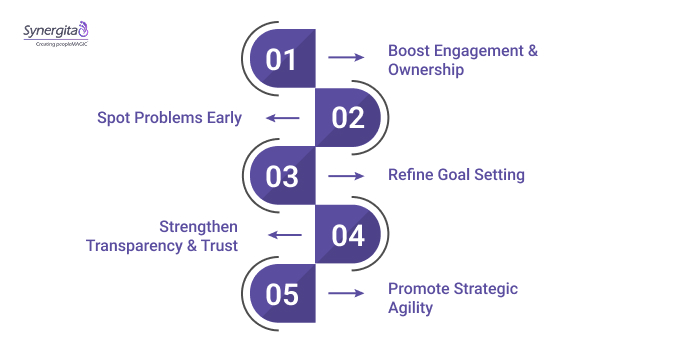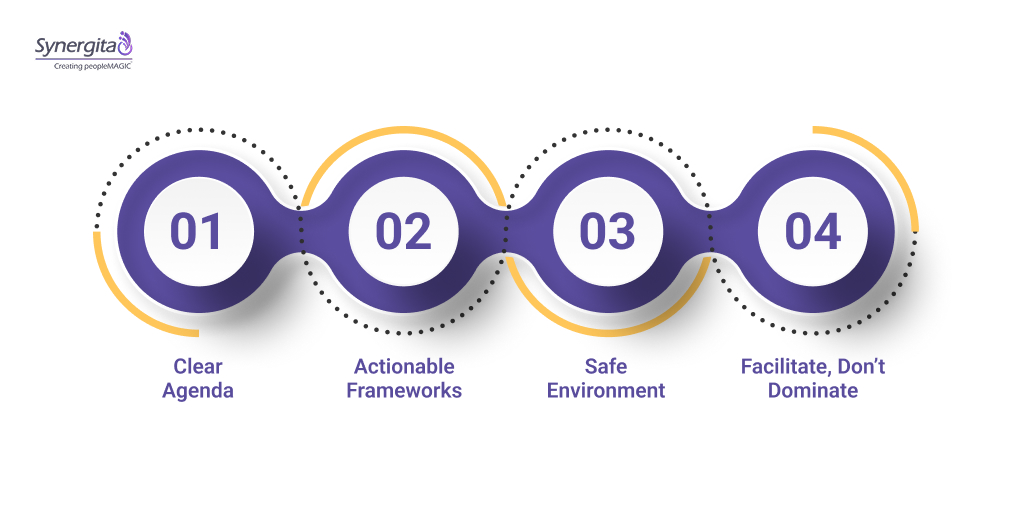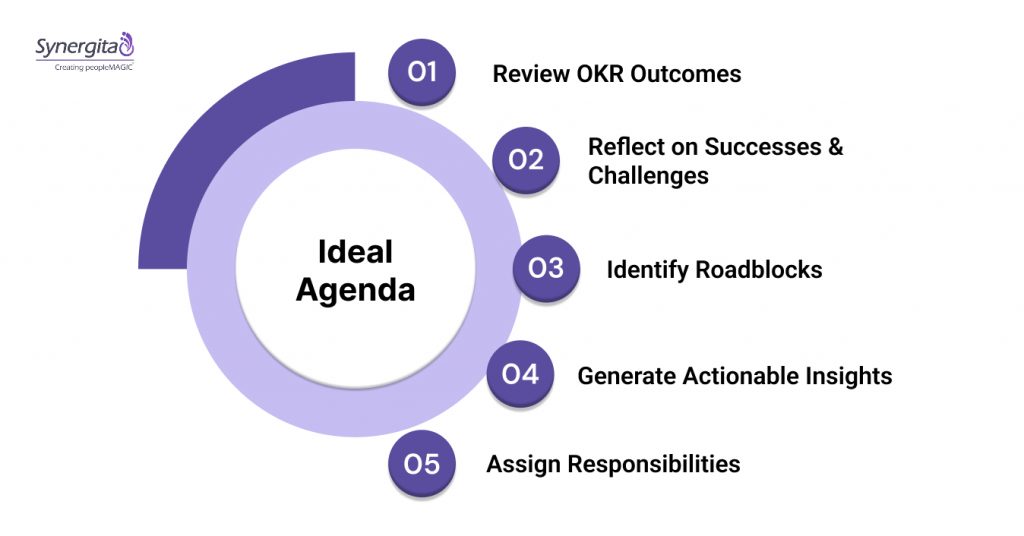Every OKR cycle tells a story — Sometimes it’s a win worth celebrating; other times, it’s a tough lesson learned through patience. The key to making each chapter better than the last? A well-run OKR retrospective. Think of it as your team’s pause button, a moment to step back, unpack what worked, what didn’t, and why.
This isn’t just about tracking numbers or hitting targets. It’s about uncovering insights that fuel smarter goal-setting, stronger alignment across teams, and better results in the next cycle. By reflecting intentionally, your team builds clarity, boosts engagement, and nurtures a culture of continuous improvement.
Key Takeaways
- OKR retrospectives are strategic, not routine — they help teams reflect, learn, and turn insights into measurable improvements every cycle.
- Structured, well‑facilitated sessions boost transparency, alignment, and engagement while keeping discussions focused and constructive.
- Effective agendas matter — from reviewing outcomes to identifying roadblocks, generating insights, and assigning clear next steps.
- Preparation is key — sharing OKR data, reports, and context upfront leads to fact‑based, higher‑quality conversations.
- Best practices drive impact — foster psychological safety, balance celebrating wins with finding growth opportunities, and keep discussions future‑focused.
- The right tools amplify results — Synergita’s OKR software streamlines tracking, alignment, and analysis, making every retrospective actionable and growth‑driven.
What Are OKR Retrospectives?
An OKR retrospective is a focused end-of-cycle session where teams look back at their goals, wins, and challenges. It’s more than checking off results; it’s about uncovering why things worked or didn’t, from team collaboration to resource use.
Held right after a quarter or OKR cycle, it gives space for honest, data-driven conversations. The goal is simple — turn lessons learned into smarter, more aligned goals for the next round.
Why OKR Retrospectives Matter — and the Big Wins They Deliver

Taking time to pause after each OKR cycle isn’t wasted effort — it’s the fastest way to improve how teams set and achieve their goals. When done consistently and effectively, retrospectives drive lasting impact on both people and performance.
- Boost Engagement & Ownership – Involving teams in decision-making makes them feel invested in outcomes. Everyone becomes a stakeholder in success.
- Spot Problems Early – Open discussions reveal systemic issues before they become recurring roadblocks, saving time and resources.
- Refine Goal Setting – Lessons learned sharpen objectives and keep them tightly aligned with company strategy.
- Strengthen Transparency & Trust – Judgment‑free feedback builds psychological safety, improving morale and collaboration.
- Promote Strategic Agility – Real insights (not assumptions) enable teams to adapt quickly to changing priorities.
The proven impact:
Organizations that embed OKRs effectively have seen turnover drop by up to 59%, product quality improve by 40%, and customer satisfaction rise by 10%. These numbers highlight how strategic alignment and continuous feedback turn reflection into measurable results.
Conducting OKR Retrospectives: Core Practices

Running a retrospective isn’t just about asking, “How did we do?” To get real value, you need structure, participation, and an open environment that turns reflection into actionable improvements.
1. Set a Clear Agenda
Define your discussion points before the session. This ensures focus and makes sure progress, challenges, and opportunities are covered.
2. Use Simple, Actionable Frameworks
Methods like Start / Stop / Continue help teams identify what to begin, halt, or maintain — producing clear next steps without overcomplicating the discussion.
3. Create a Safe, Open Environment
Encourage honest feedback without blame. Psychological safety keeps participants engaged and willing to share.
4. Facilitate, Don’t Dominate
A skilled facilitator ensures balanced participation, keeps things on track, and focuses on learning instead of fault-finding.
What Does an Ideal Agenda for the OKR Retrospective Look Like?

Once your core practices are in place, this agenda can guide the flow of a productive 60 to 90-minute session.
1. Review OKR Outcomes (15–20 min)
- Present data and reports on what was achieved for each objective and key result.
- Highlight both successes and areas that fell short.
2. Reflect on Successes and Challenges (15 min)
- Use Start / Stop / Continue or a similar framework.
- Pull out patterns and moments that made the biggest impact — positive or negative.
3. Identify Roadblocks & Root Causes (10–15 min)
- Discuss specific barriers — resource gaps, unclear roles, shifting priorities.
- Capture causes and note which are solvable internally vs. externally.
4. Generate Actionable Insights (10–15 min)
- Brainstorm improvements or experiments for the next cycle.
- Prioritize based on feasibility and impact.
5. Assign Responsibilities & Next Steps (5–10 min)
- Give owners to each action item.
- Ensure deadlines and follow-ups are agreed upon.
Preparing for an Effective OKR Retrospective
Good preparation sets the stage for a focused and effective OKR retrospective that delivers real value.
- Schedule early to give participants time to gather thoughts and relevant data.
- Share OKR reports and analytics in advance so insights are evidence-based.
- Choose the correct format and duration — around 30 minutes for smaller teams, up to 90 minutes for larger or cross-functional groups.
- Ensure smooth collaboration by testing your tech setup for both in-person and virtual meetings.
What Are the Best Practices to Consider for an OKR Retrospective?
To maximize the impact of retrospectives, consider these best practices:
- Ensure readiness: All participants should come prepared with data and insights.
- Promote evidence-based discussion: Focus on facts rather than opinions.
- Maintain psychological safety: Encourage openness without blame.
- Keep discussions future-oriented: Avoid dwelling on past mistakes; focus on improvement.
- Balance feedback: Celebrate wins while identifying growth areas.
Following these steps transforms retrospectives into valuable forums for team development and strategic alignment.
Key Strategies for High-Impact Retrospectives
Balance is essential in retrospectives. While it is important to highlight areas for improvement, it is equally valuable to celebrate achievements. Recognizing wins—big and small—boosts morale and motivation.
From the discussion, derive clear, prioritized action points that address challenges and enhance processes. Assign ownership for follow-up tasks to ensure accountability and momentum post-retrospective. This step transforms reflections into tangible improvements.
What Are the Ideal Outcomes of an OKR Retrospective?

Effective retrospectives should result in:
- Clear understanding of successes and failures: The team recognizes what contributed to or hindered progress.
- Prioritized action items: Concrete steps for improving future OKR cycles are agreed upon.
- Enhanced team alignment: Everyone shares a consistent understanding of goals and challenges.
- Stronger collaboration: Feedback loops improve interpersonal communication and trust.
- Continuous improvement culture: Reflection becomes a habitual part of the team rhythm.
Achieving these outcomes ensures that the OKR process evolves positively with every cycle.
Common Pitfalls and Best Practices
A great retrospective can quickly lose its impact if these common mistakes slip in.
- Poor preparation – Without relevant data or insights, discussions stay shallow. Share OKR reports and feedback in advance so participants arrive ready.
- Lack of focus – An unclear agenda leads to scattered conversations. Use a simple structure to keep discussions on track.
- Unconstructive feedback – Personal or overly negative comments block progress. Keep feedback about processes, not people, and focus on the future.
Retrospectives work best as safe spaces for learning that turn evidence and collaboration into better results for the next cycle.
The Role of Questions in OKR Retrospectives

Asking the right questions turns a retrospective from a casual review into a powerful learning session.
1. Evaluate OKR Achievement
- Did the team achieve each objective?
- Were the key results measurable and realistic?
- For example, if the goal was to improve customer retention by 10%, what did actual data show?
- Check if the goals matched the team’s capacity and the company’s priorities.
2. Identify Roadblocks
- What slowed progress — resource shortages, unclear roles, market changes?
- Were there communication gaps or shifting priorities?
- Pinpointing these makes it easier to prevent them next cycle.
3. Assess Engagement and Clarity
- Did everyone understand their role in achieving the OKRs?
- Were the objectives motivating enough?
- Did the team have the right tools, skills, and information to succeed?
By keeping questions clear and specific, you shift the discussion from being general to uncovering concrete, actionable insights.
Making OKR Retrospectives a Growth Habit
OKR retrospectives are more than a simple review — they’re a powerful tool for driving continuous improvement. By reflecting on what worked, what didn’t, and why, teams can turn insights into meaningful, measurable actions. The result? Greater transparency, stronger alignment, and a culture where learning fuels progress.
With the right structure and skilled facilitation, retrospectives can evolve from a routine checkpoint into a strategic engine for change. They help teams stay focused on priorities, adapt faster, and consistently raise performance.
And when paired with the right tools, the process becomes seamless. Synergita’s OKR software brings everything together — from progress tracking and goal alignment to real‑time dashboards and AI‑driven insights. This ensures your retrospective discussions are fact‑based, focused, and actionable.
Transform your retrospectives into a consistent engine for growth and success. Start your Synergita free trial today and power up your OKRs. Or boost your potential with our other resources for tips winning teams swear by, and keep your team ahead of the game.
FAQs
1. What if our retrospective discussions become too negative?
Use a structured framework (like Start / Stop / Continue) to balance positives with areas for improvement. Explicitly set a “blame‑free” tone at the start to keep conversations constructive.
2. How can we keep retrospectives from running too long?
Share data and relevant updates in advance, stick to a timed agenda, and appoint a facilitator to keep the conversation focused while ensuring all voices are heard.
3. How do we ensure retrospective insights turn into action?
End the session by turning feedback into 2–3 clear, prioritized action items, assigning ownership, and setting timelines for delivery. Review progress in the next retrospective.
4. What are some signs our retrospectives are working?
You’ll see better alignment in the next OKR cycle, quicker resolution of recurring issues, more engaged participants, and measurable improvements in goal achievement rates.
5. Can we combine OKR retrospectives with other review formats?
Yes — some teams merge them with sprint retrospectives or quarterly business reviews to save time and ensure strategic and tactical learnings are connected.



